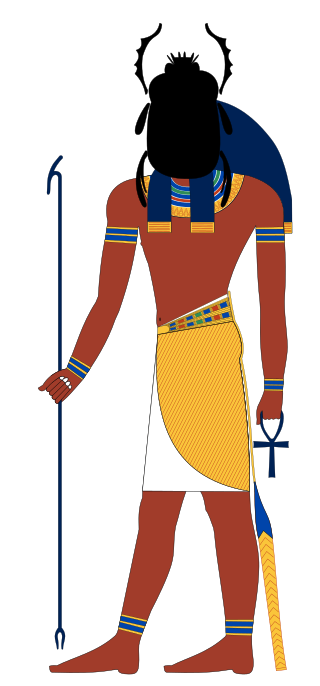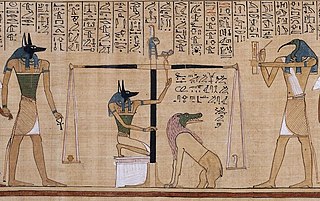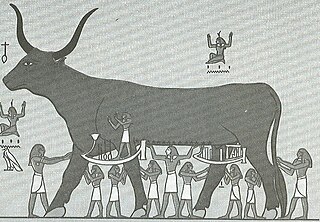Ancient Egyptian religion was a complex system of polytheistic beliefs and rituals that formed an integral part of ancient Egyptian culture. It centered on the Egyptians' interactions with many deities believed to be present and in control of the world. About 1500 deities are known. Rituals such as prayer and offerings were provided to the gods to gain their favor. Formal religious practice centered on the pharaohs, the rulers of Egypt, believed to possess divine powers by virtue of their positions. They acted as intermediaries between their people and the gods, and were obligated to sustain the gods through rituals and offerings so that they could maintain Ma'at, the order of the cosmos, and repel Isfet, which was chaos. The state dedicated enormous resources to religious rituals and to the construction of temples.

The Osiris myth is the most elaborate and influential story in ancient Egyptian mythology. It concerns the murder of the god Osiris, a primeval king of Egypt, and its consequences. Osiris's murderer, his brother Set, usurps his throne. Meanwhile, Osiris's wife Isis restores her husband's body, allowing him to posthumously conceive their son, Horus. The remainder of the story focuses on Horus, the product of the union of Isis and Osiris, who is at first a vulnerable child protected by his mother and then becomes Set's rival for the throne. Their often violent conflict ends with Horus's triumph, which restores maat to Egypt after Set's unrighteous reign and completes the process of Osiris's resurrection.

Khepri is a scarab-faced god in ancient Egyptian religion who represents the rising or morning sun. By extension, he can also represent creation and the renewal of life.

Ammit was an ancient Egyptian goddess with the forequarters of a lion, the hindquarters of a hippopotamus, and the head of a crocodile—the three largest "man-eating" animals known to ancient Egyptians. In ancient Egyptian religion, Ammit played an important role during the funerary ritual, the Judgment of the Dead.

Nehebkau was the primordial snake god in ancient Egyptian mythology. Although originally considered an evil spirit, he later functions as a funerary god associated with the afterlife. As one of the forty-two assessors of Ma’at, Nehebkau was believed to judge the deceased after death and provide their souls with ka – the part of the soul that distinguished the living from the dead.

The ancient Egyptians believed that a soul was made up of many parts. In addition to these components of the soul, there was the human body.

The Book of the Dead is the name given to an ancient Egyptian funerary text generally written on papyrus and used from the beginning of the New Kingdom to around 50 BC. "Book" is the closest term to describe the loose collection of texts consisting of a number of magic spells intended to assist a dead person's journey through the Duat, or underworld, and into the afterlife and written by many priests over a period of about 1,000 years. In 1842, the Egyptologist Karl Richard Lepsius introduced for these texts the German name Todtenbuch, translated to English as 'Book of the Dead'. The original Egyptian name for the text, transliterated rw nw prt m hrw, is translated as Spells of Coming Forth by Day.
The Amduat[pronunciation?] is an important ancient Egyptian funerary text of the New Kingdom of Egypt. Similar to previous funerary texts, such as the Old Kingdom's Pyramid Texts, or the First Intermediate Period's Coffin Texts, the Amduat was found carved on the internal walls of a pharaoh's tomb. Unlike other funerary texts, however, it was reserved almost exclusively for pharaohs until the Twenty-first Dynasty, or very select nobility.

The ushabti was a funerary figurine used in ancient Egyptian funerary practices. The Egyptological term is derived from 𓅱𓈙𓃀𓏏𓏭𓀾 wšbtj, which replaced earlier 𓆷𓍯𓃀𓏏𓏭𓀾 šwbtj, perhaps the nisba of 𓈙𓍯𓃀𓆭 šwꜣb "Persea tree".

The ancient Egyptians had an elaborate set of funerary practices that they believed were necessary to ensure their immortality after death. These rituals included mummifying the body, casting magic spells, and burials with specific grave goods thought to be needed in the afterlife.

The Coffin Texts are a collection of ancient Egyptian funerary spells written on coffins beginning in the First Intermediate Period. They are partially derived from the earlier Pyramid Texts, reserved for royal use only, but contain substantial new material related to everyday desires, indicating a new target audience of common people. Coffin texts are dated back to 2100 BCE. Ordinary Egyptians who could afford a coffin had access to these funerary spells and the pharaoh no longer had exclusive rights to an afterlife.

The Pyramid Texts are the oldest ancient Egyptian funerary texts, dating to the late Old Kingdom. They are the earliest known corpus of ancient Egyptian religious texts. Written in Old Egyptian, the pyramid texts were carved onto the subterranean walls and sarcophagi of pyramids at Saqqara from the end of the Fifth Dynasty, and throughout the Sixth Dynasty of the Old Kingdom, and into the Eighth Dynasty of the First Intermediate Period. The oldest of the texts have been dated to c. 2400–2300 BCE.

The opening of the mouth ceremony was an ancient Egyptian ritual described in funerary texts such as the Pyramid Texts. From the Old Kingdom to the Roman Period, there is ample evidence of this ceremony, which was believed to give the deceased their fundamental senses to carry out tasks in the afterlife. Various practices were conducted on the corpse, including the use of specific instruments to touch body parts like the mouth and eyes. These customs were often linked with childbirth, which denoted rebirth and new beginnings. For instance, cutting bloody meat from animals as offerings for the deceased signified the birthing process, which typically involves blood, and represented the commencement of a new life. Additionally, tools like the peseshkef, which resembled the tail of a fish and were originally employed for cutting infants' umbilical cords, further emphasized the idea of "rebirth".

The four sons of Horus were a group of four deities in ancient Egyptian religion who were believed to protect deceased people in the afterlife. Beginning in the First Intermediate Period of Egyptian history, Imsety, Hapy, Duamutef, and Qebehsenuef were especially connected with the four canopic jars that housed the internal organs that were removed from the body of the deceased during the process of mummification. Most commonly, Imsety protected the liver, Hapy the lungs, Duamutef the stomach, and Qebehsenuef the intestines, but this pattern often varied. The canopic jars were given lids that represented the heads of the sons of Horus. Although they were originally portrayed as humans, in the latter part of the New Kingdom, they took on their most distinctive iconography, in which Imsety is portrayed as a human, Hapy as a baboon, Duamutef as a jackal, and Qebehsenuef as a falcon. The four sons were also linked with stars in the sky, with regions of Egypt, and with the cardinal directions.

The pyramid of Unas is a smooth-sided pyramid built in the 24th century BC for the Egyptian pharaoh Unas, the ninth and final king of the Fifth Dynasty. It is the smallest Old Kingdom pyramid, but significant due to the discovery of Pyramid Texts, spells for the king's afterlife incised into the walls of its subterranean chambers. Inscribed for the first time in Unas's pyramid, the tradition of funerary texts carried on in the pyramids of subsequent rulers, through to the end of the Old Kingdom, and into the Middle Kingdom through the Coffin Texts that form the basis of the Book of the Dead.
The Spell of the Twelve Caves is an ancient Egyptian funerary text from the New Kingdom. The earliest known copy is on a papyrus found in KV35 the tomb of Amenhotep II, and another copy was inscribed in the Osireion at Abydos under Merenptah. Although the text also appears in some copies of the Book of the Dead, where it is classified as Spell 168, the Egyptologist Alexandre Piankoff treated it as a distinct composition.

Egyptian mythology is the collection of myths from ancient Egypt, which describe the actions of the Egyptian gods as a means of understanding the world around them. The beliefs that these myths express are an important part of ancient Egyptian religion. Myths appear frequently in Egyptian writings and art, particularly in short stories and in religious material such as hymns, ritual texts, funerary texts, and temple decoration. These sources rarely contain a complete account of a myth and often describe only brief fragments.

The Book of the Heavenly Cow, or the Book of the Cow of Heaven, is an Ancient Egyptian text thought to have originated during the Amarna Period and, in part, describes the reasons for the imperfect state of the world in terms of humankind's rebellion against the supreme sun god, Ra. Divine punishment was inflicted through the goddess Hathor, with the survivors suffering through separation from Ra, who now resided in the sky on the back of Nut, the heavenly cow.
The Book of Traversing Eternity is an ancient Egyptian funerary text used primarily in the Roman period of Egyptian history. The earliest known copies date to the preceding Ptolemaic Period, making it most likely that the book was composed at that time.

Ancient Egyptian afterlife beliefs were centered around a variety of complex rituals that were influenced by many aspects of Egyptian culture. Religion was a major contributor, since it was an important social practice that bound all Egyptians together. For instance, many of the Egyptian gods played roles in guiding the souls of the dead through the afterlife. With the evolution of writing, religious ideals were recorded and quickly spread throughout the Egyptian community. The solidification and commencement of these doctrines were formed in the creation of afterlife texts which illustrated and explained what the dead would need to know in order to complete the journey safely.















